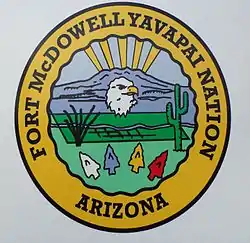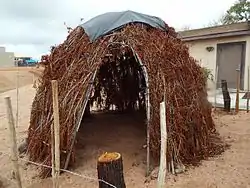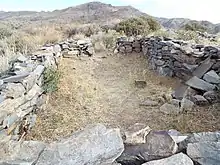Indigenous peoples of Arizona
Indigenous peoples of Arizona are the Native American people of the state of Arizona. These include people that have lived in the region since time immemorial, tribes who entered the region centuries ago, such as the Southern Athabascan peoples, and the Pascua Yaqui, who settled Arizona en masse in the early 20th century.[1]
| Part of a series on |
| Native Americans in the United States |
|---|
Arizona has the third largest Native American population of any U.S. state.[2]
Almost a quarter of Arizona is reservation land. The Navajo Nation has the largest reservation in the United States, and the Tohono O'odham Nation in southeast Arizona has the second-largest reservation.[2]
There are 17 federally recognized tribes completely within the borders of Arizona, and 5 more in Arizona whose territory spans multiple states. Of these, 20 tribes are members of the Inter-Tribal Council of Arizona (ITCA).[3]
Native American tribes in Arizona today


Solely located in Arizona
- Ak Chin Indian Community of the Maricopa (Ak Chin) Indian Reservation, Arizona
- Cocopah Tribe of Arizona
- Fort McDowell Yavapai Nation, Arizona
(formerly the Fort McDowell Mohave-Apache Community of the Fort McDowell Indian Reservation) - Gila River Indian Community of the Gila River Indian Reservation, Arizona
- Havasupai Tribe of the Havasupai Reservation, Arizona
- Hopi Tribe of Arizona
- Hualapai Indian Tribe of the Hualapai Indian Reservation, Arizona
- Kaibab Band of Paiute Indians of the Kaibab Indian Reservation, Arizona
- Pascua Yaqui Tribe of Arizona
- Salt River Pima-Maricopa Indian Community of the Salt River Reservation, Arizona
- San Carlos Apache Tribe of the San Carlos Reservation, Arizona
- San Juan Southern Paiute Tribe of Arizona
- Tohono O'odham Nation of Arizona
(formerly Papago Indian Tribe) - Tonto Apache Tribe of Arizona
- White Mountain Apache Tribe of the Fort Apache Reservation, Arizona
- Yavapai-Apache Nation of the Camp Verde Indian Reservation, Arizona
- Yavapai-Prescott Tribe of the Yavapai Reservation, Arizona
Crossing state lines
- Colorado River Indian Tribes of the Colorado River Indian Reservation, Arizona and California (these include Chemehuevi, Mojave, Hopi, and Navajo people)
- Fort Mojave Indian Tribe of Arizona, California and Nevada
- Navajo Nation, Arizona, New Mexico and Utah
- Quechan Tribe of the Fort Yuma Indian Reservation, California and Arizona
- Zuni Tribe of the Zuni Reservation, New Mexico
Indigenous ethnic groups who lived in Arizona
Several of the Colorado River tribes are headquartered across the state line in California but have historical connections to Arizona. These include the Chemehuevi, Cocopah (Xawitt Kwñchawaay), Quechan (Yuma), and Mojave (Hamakhava). Many of these are Yuman-speaking peoples.
Yuman language-speaking peoples connected to Arizona include the Havasupai (Havasuw `Baaja), Walapai, Yavapai, Mojave, Hualapai (Hwal `Baaja), Halchidhoma (Xalychidom), Quechan, Maricopa (Piipaash), and Cocopah.
Colorado River Numic language–speakers connected to Arizona include the Southern Paiute, Southern Ute and Chemehuevi.
The Navajo (Diné) and Apache are Southern Athabascan-speaking people who migrated into the American Southwest from the north, possibly around 1300 CE.[4] Apache bands connected to Arizona include the Dilzhe'e Apache, Chiricahua, San Carlos Apache (Nné, Coyotero, or Western Apache), White Mountain Apache
Oʼodham language–speakers include the Akimel O'odham (formerly Pima), Tohono O'odham, and Hia C-eḍ Oʼodham.
Pueblo peoples living in Arizona include the Hopi, Tewa, and Zuni (A:shiwi).
The Yaqui people speak a Uto-Aztecan language.
Precontact cultures of Arizona

- Ancestral Pueblo peoples, Four Corners area
- Hohokam (Ho:-ho:gam), as far north as the Valley of the Sun and as far south as Mexico.
- Mogollon, southeast Arizona, New Mexico, Sonora, Chihuahua, west Texas
- Patayan, far western Arizona, California
- Sinagua, area around present-day Flagstaff
References
- Miller, Mark Edwin (2006). Forgotten Tribes: Unrecognized Indians and the Federal Acknowledgment Process. Lincoln: University of Nebraska Press. pp. 80–81. ISBN 978-0803283213.
- "US States With The Largest Native American Populations". WorldAtlas. Retrieved 16 May 2022.
- Inter-Tribal Council of Arizona
- Seymour, Deni J. (May 2012). "Gateways for Athabascan Migration to the American Southwest". Plains Anthropologist. 57 (222): 149.
External links
- U.S. Department of the Interior
- Bureau of Indian Affairs
- Tribal Leaders Directory Spring/Summer 2005
- Native Americans in Arizona – timeline, map, cultures
- Ak Chin Indian Community of the Maricopa (Ak Chin) Indian Reservation
- Cocopah Tribe of Arizona
- Colorado River Indian Tribes of the Colorado River Indian Reservation, Arizona and California
- Fort McDowell Yavapai Nation
- Fort Mojave Indian Tribe of Arizona, California & Nevada
- Gila River Indian Community
- Havasupai Tribe of the Havasupai Reservation
- Hopi Tribe of Arizona
- Hualapai Indian Tribe of the Hualapai Indian Reservation
- Kaibab Band of Paiute Indians of the Kaibab Indian Reservation
- Navajo Nation, Arizona, New Mexico & Utah
- Pascua Yaqui, Arizona, Mexico
- Quechan Tribe of the Fort Yuma Indian Reservation, California & Arizona
- Salt River Pima–Maricopa Indian Community of the Salt River Reservation
- San Carlos Apache Tribe of the San Carlos Reservation
- San Juan Southern Paiute Tribe of Arizona
- Tohono O'odham Nation of Arizona
- Tonto Apache Tribe of Arizona
- White Mountain Apache Tribe of the Fort Apache Reservation
- Yavapai–Apache Nation of the Camp Verde Indian Reservation
- Yavapai–Prescott Tribe of the Yavapai Reservation
